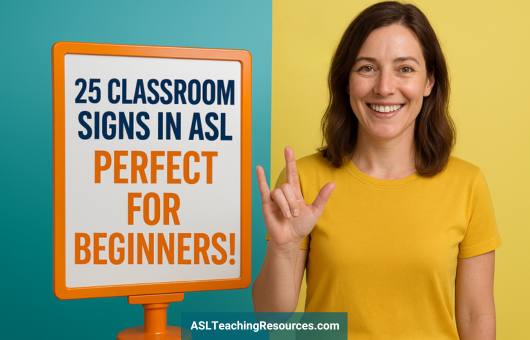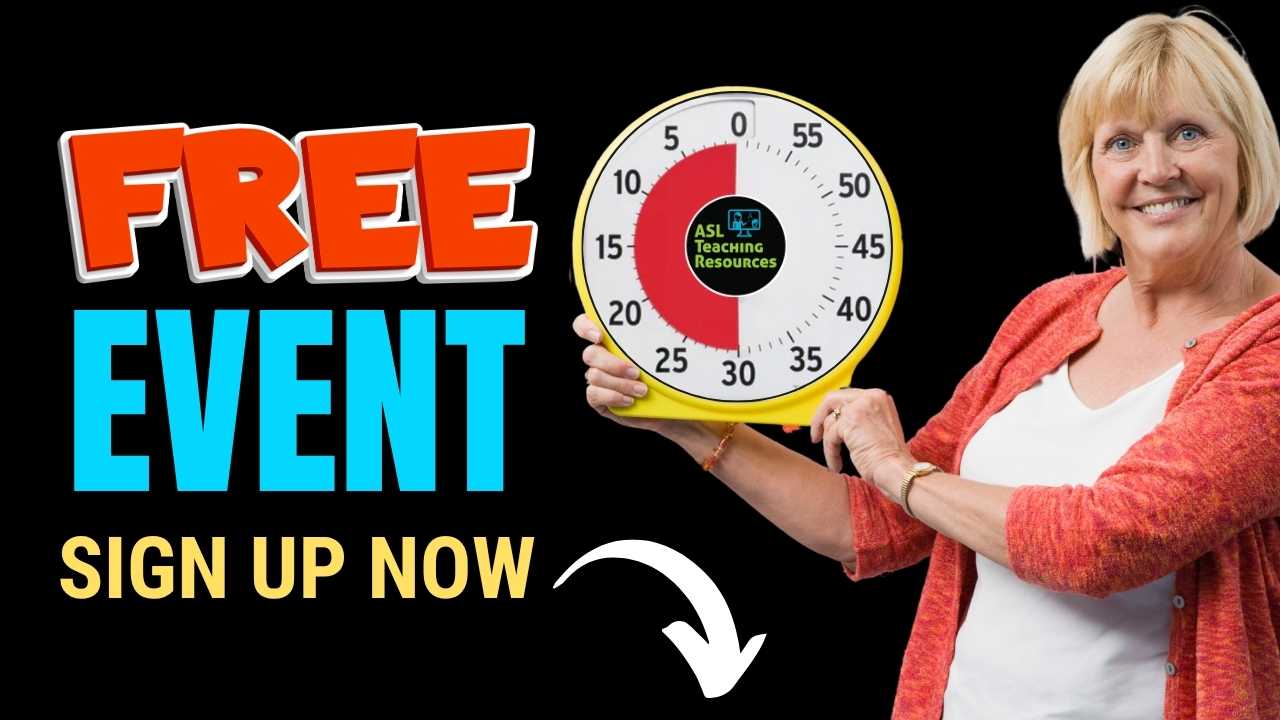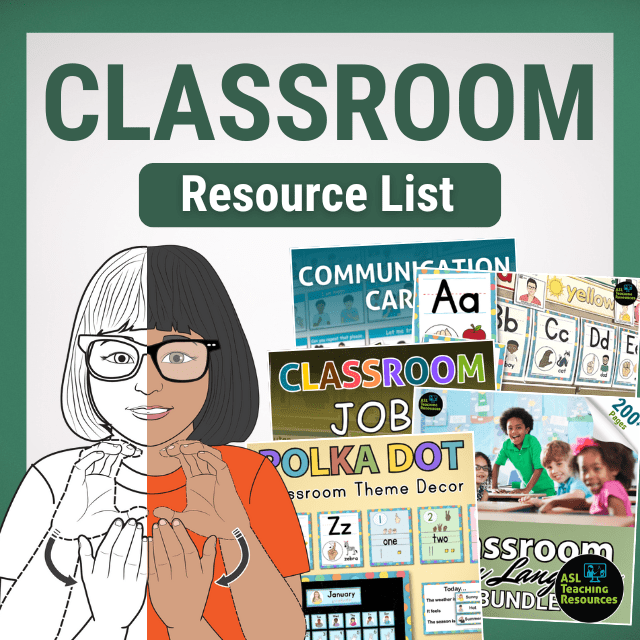You’re standing in front of a room full of curious, wiggly little humans. You ask them to “line up nicely,” and instead, someone’s crawling under a table, someone else is spinning in circles, and you’re silently wishing for a magical classroom wand.
Well, surprise: your hands are the wand. And American Sign Language for beginners just might be your secret classroom superpower.
I’ll show you how just 25 simple signs can transform your classroom vibes with less shouting and more connecting. Even if you’ve never signed a single word before, this is for you. And your kids, they’re going to love it!
👋 Why ASL in the Classroom Works, Even for Beginners
If you’re wondering how to learn sign language for beginners, especially with a class full of active kiddos, here’s some good news: you don’t have to be fluent to make an impact.

Adding just a handful of sign language for the classroom makes routines smoother, transitions quicker, and behavior management… actually manageable.
Are you ready for the best part? ASL is visual, so kids pick it up crazy fast. Especially when paired with fun and movement.
Whether you’re a teacher, homeschooler, speech pathologist, or daycare rockstar, ASL can help every child, especially those who are deaf, hard of hearing, or non-verbal, feel seen and understood.
✋ Let’s Get Signing! Your First 25 Classroom Signs
These American Sign Language for beginners signs are classroom gold. They’re perfect for sign language classroom management and daily routines.
✅ Everyday Routines
- Bathroom
- Eat
- Drink
- More
- All Done
- Help
- Stop
These signs cut down on interruptions big time. A student quietly signing “bathroom” from across the room? Yes, please.
😄 Encouragement & Emotions
- Good job
- Happy
- Sad
- I love you
- Friend
- Sorry
ASL helps kids name feelings and connect with empathy, even those still developing language skills.
🚦Transitions & Directions
- Line up
- Sit
- Stand
- Wait
- Go
- Clean up
- Quiet
Pair signs with spoken directions and watch how quickly kids start to anticipate what you want, without the 10 verbal reminders.
📚 Learning Time
- Book
- Write
- Read
- Listen
- Teacher
- Student
Use these during lessons, centers, or group work. Plus, it’s a built-in movement break!
🛍️ Learn With Us: Hands-On ASL Help
Everything you need to get started with these 25 classroom signs, designed to make your life easier and your classroom calmer.
Ready to bring ASL into your classroom without guessing your way through YouTube?
🎉 Try This:
ASL in the Classroom: Top Elementary Signs is our best-selling guide for busy teachers, homeschoolers, and speech therapists.
Inside you’ll get:
- Step-by-step instructions
- Real classroom use cases
- Immediate, practical signs to start today
📹 Watch and Learn with Our Beginner Video Playlist
Some folks are visual learners (you know who you are). We’ve got you covered with our sign language beginner videos over on YouTube.
👉 Watch the ASL for the Classroom Playlist
Perfect for visual reinforcement, morning meetings, and even sending home to families who want to practice with their kiddos.
While you’re there, subscribe to get short, fun, classroom-friendly videos every week.
👩🏫 From Chaos to Calm: Story Time (True Tale!)
A kindergarten teacher, Mrs. Taylor, started using just five ASL signs with her students: sit, quiet, help, bathroom, and all done. Her classroom flipped in just one week. Her most energetic students responded instantly. Her non-verbal student smiled when she saw others using signs too.

Within a month? She had a signing classroom, without ever taking an ASL course.
It doesn’t have to be hard. Just consistent.
🧠 Tips for Teaching ASL to Kids (Even if You’re New Too)
- Start with 3–5 signs. Introduce them during circle time or transition moments.
- Use them consistently. Pair every verbal cue with the sign.
- Model often. Kids mimic what they see, especially when it’s fun.
- Make it visual. Use posters, word walls, or flashcards.
- Celebrate progress! Cheer when students sign back, even if it’s imperfect.
🙋 FAQ: Sign Language Beginners Often Ask
A: Keep it simple and fun. Start with everyday words, watch beginner videos, and use visual tools like flashcards or posters.
Q: Can I teach my class sign language even if I’m not fluent?
A: Absolutely! You only need to know a few signs to make a big difference. You’re learning with your students.
Q: What signs should I teach first in the classroom?
A: Start with helpful, high-frequency signs like bathroom, help, sit, quiet, and all done.
Q: Where can I find videos for sign language beginners?
A: Right here: ASL Teaching Resources on YouTube. Short, clear, and classroom-friendly.
Q: Is ASL only for students who are deaf?
A: Nope! ASL supports all kinds of learners, including those with speech delays, autism, and those who just learn better visually.
♥️ Need more help building your ASL toolkit?
Don’t miss the Classroom Must-Haves Resource List, a free download to keep you on track!
We’re here to help you succeed.
➡️ Grab this ready-to-use resource list from ASL Teaching Resources.
🛒 Love Our Printables? You can also shop your favorite ASL Teaching Resources on Amazon!
💬 Key Takeaways for Sign Language Beginners
- American Sign Language for beginners is easier than you think.
- ASL is a game-changer in classrooms, especially for non-verbal, deaf, or neurodiverse learners.
- Start with 25 beginner signs that boost communication and reduce stress.
- You don’t need to be fluent, just consistent and willing.
- ASL helps every child feel seen, supported, and part of the group.
- Use visual tools, short videos, and helpful kits to make it work for you.
🎉 Ready to get started?
Let’s make signing part of your everyday teaching magic!
👉 Start small, stay playful!
👉 Explore more ASL in the Classroom products
👉 Browse ASL Classroom Must-Haves
👉 Subscribe to our YouTube channel
👉 Buy Sign Language books on Amazon.
Related ASL Resources:
- American Sign Language Chart Essentials: Visual Aids Every Teacher Needs
- Sign Language Alphabet: A Fun Way to Learn ASL ABCs
- Teaching Preschoolers: The Ultimate Game-Changer
- Teaching Sign Language in the Classroom: 5 Really Simple & Fun Ways
- How to Learn ASL Fast and Easy
- Building Global Momentum to Introduce Sign Language in Early Childhood Education
- Benefits of Sign Language for Autism
- Success for Kids with Hearing Loss
- ASL Picture Books





